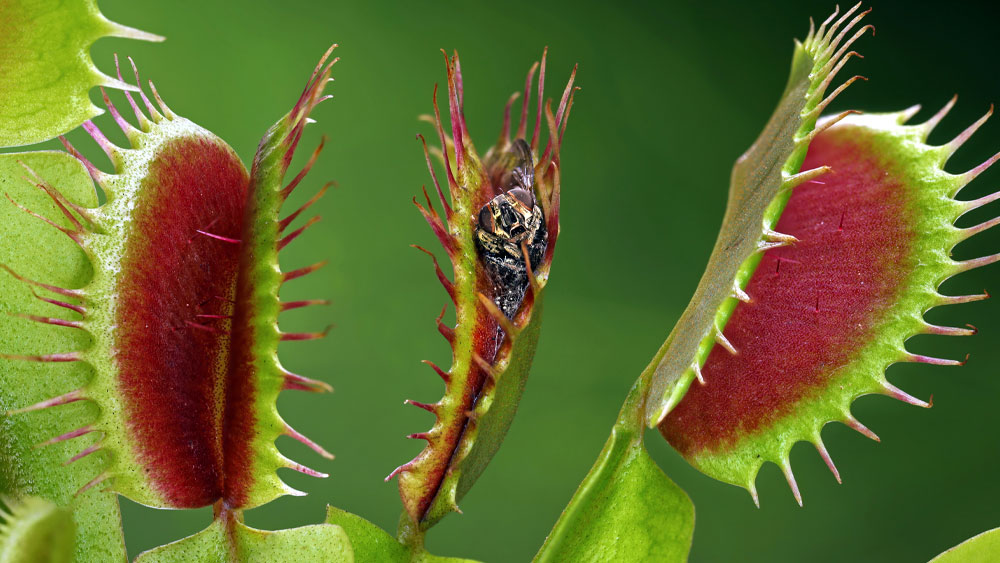Fascinating discoveries have been made regarding the amazing Venus flytrap (Dionaea muscipula).1 For example, all parts of this amazing plant must work together to maintain its carnivorous function. ICR’s Brian Thomas said:
...the Venus flytrap is irreducibly complex, which is to say that if one part is removed, the whole system is rendered useless. For example, if snap-trap plants could not discern insects from inedible items, random debris would trigger the doors but provide no nutrients. The plant can only reload three or four times before it must reap some benefits from its labor.2
Fires are a constant threat in the wild, but God has designed plants and animals to sense heat and respond.3 Obviously, plants cannot flee from the flames, but in the case of the Venus flytrap, Christ has designed an amazing system to protect the vital snap traps and sensory hairs from fire.
Recently, biophysicists at the University of Würzburg in Germany found that this remarkable plant of North Carolina can be surrounded by dry grass in the summer, but they recognize a difficulty with the discovery.
Without natural fire, the Dionaea populations would decline. How does Dionaea survive and even thrive after swamp fires? Here, we ask whether flytraps recognize heat waves at the forefront of swamp fires and demonstrate that a heat-sensor-based alarm may provide a fire survival strategy for them. In this study, we show that flytraps become electrically excited and close in response to a heat wave.4
“[A] heat-sensor-based alarm” certainly doesn’t sound like it’s a result of chance, time, and natural processes (evolution). In addition, the flytrap evidently can sense the wave of heat which comes ahead of the fire itself. “The JMU [Julius-Maximilians-University] researchers were correct in their assumption: a hot air blower directed at the trap was sufficient to cause the trap to close.”5
The Lord Jesus has designed a number of critical signaling systems inside cells using the element calcium. Calcium ions (Ca2+) can enter the plant cell through receptor-gated or voltage-gated calcium channels in the cell’s membrane. The Science Daily article reports,
...[The researchers] are pursuing the hypothesis that a calcium channel is an integral part of the heat sensor, or even the sensor itself. If this is true, a type of membrane-bound temperature sensor would have been discovered that is still completely unknown in plants. So far, research knows calcium channels from the so-called OSCA family [calcium-permeable channel], which can be activated mechanically and osmotically [fluid passing through a semipermeable membrane from an area of low solute concentration to a higher solute concentration].”5
One of the more amazing discoveries in this research was a heat sensor in the flytrap leaf that activates at 37 and 55 degrees Celsius, producing specific action potentials. This taps into what biochemists have described as the depolarization of the membrane called the all-or-nothing law.
[Dr. Shouguang Huang] found that when a local leaf temperature of 37 degrees Celsius was exceeded, the heated area of the trap produced an electrical impulse, an action potential that spread across both halves of the trap. "When the temperature increased further to 55 degrees Celsius, a second action potential was triggered and the trap snapped shut," Shouguang said. But the trap's reaction at 37 and 55 degrees Celsius only kicked in when temperatures increased abruptly, as in a rapid heat wave.5 (Emphasis added)
Thus, not only does this plant have a thermometer to measure preset temperatures, but it also has a stopwatch of sorts that measures the speed of temperature change—and both functions come fully integrated with each other and with the plant—just like they were put there on purpose.
ICR biology has been developing a model called Continuous Environmental Tracking (CET). It purports that the Creator equipped animals and plants with sensors, logic, and outputs.6 The discovery of exactly these features in the flytrap adds to the growing list of examples of CET in action.
To conclude, Huang and Hedrich said in Current Biology something that creationists attribute to the incredible design brought about by the Lord Jesus, “We propose that by sensing the temperature differential, flytraps can recognize the heat of an approaching fire, thus closing before the trigger hairs are burned, while they can continue to catch prey throughout hot summers.”4
References
- Sherwin, F. The Venus Flytrap’s Snap. Acts & Facts. 51 (9).
- Thomas, B. Flytrap Origins: A Sticky Problem for Evolution. Creation Science Update. Posted on ICR.org June 25, 2009, accessed September 6, 2023.
- Sherwin, F. The Amazing Jewel Beetle. Acts & Facts. 36 (5).
- Huang, S. and R. Hedrich. 2023. Trigger hair thermoreceptors provide for heat-induced calcium-electrical excitability in Venus flytrap. Pubmed.ncbi.nlm. Posted on pubmed.ncbi.nlm.nih.gov August 16, 2023, accessed September 6, 2023.
- Science Writer. Heat sensor protects the Venus flytrap from fire. ScienceDaily. Posted on sciencedaily.com August 22, 2023, accessed September 6, 2023.
- Guliuzza, R. Engineered Adaptability: Continuous Environmental Tracking Wrap-Up. Acts & Facts. 48 (8).
* Dr. Sherwin is science news writer at the Institute for Creation Research. He earned an M.A. in zoology from the University of Northern Colorado and received an Honorary Doctorate of Science from Pensacola Christian College.














